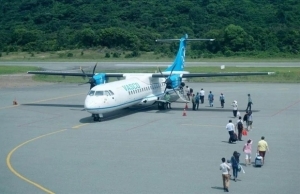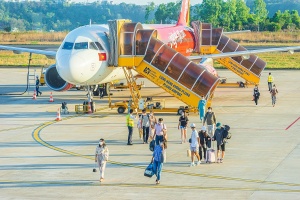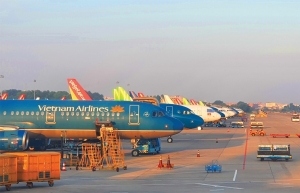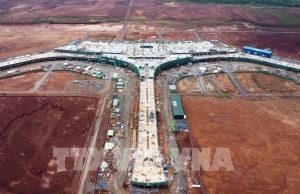Vietnam’s airport industry can break down barriers to secure investments
To facilitate this growth, the government has proposed investment of VND400 trillion ($17.65 billion) in airport development from now towards 2030 with a vision to 2050. However, attracting sufficient investment to realise these ambitious plans poses several challenges.
 |
| Eric Johnson, Lawyer (left) and Trung Duong Lawyer Freshfields Bruckhaus Deringer LLP |
Vietnam’s rapidly expanding tourism industry and growing business sectors have significantly increased air traffic, positioning airport development as a potentially attractive investment opportunity for both foreign and domestic investors. Additionally, Vietnam’s strategic position in Southeast Asia enhances its appeal as a regional transportation hub, which would also support increased investments into adjacent businesses such as aviation services.
In addition, potential investors should be aware that there is significant government support for foreign and domestic investments into airport infrastructure, at least in principle if not yet in practice.
For example, the government’s Decree No.05/2021/ND-CP sets forth investment conditions for airport projects, creating a structured pathway for investors. Similarly, Decree No.92/2016/ND-CP permits foreign entities to hold up to 30 per cent ownership in airport projects, encouraging international capital while balancing national security concerns.
Private sector funding
However, despite the potential, challenges remain. Lengthy approval procedures for investment and construction, bureaucratic inefficiencies, and regulatory ambiguities have slowed progress in the development of private airport infrastructure. One example of this is that under the current law, investments in the form of public-private partnerships (PPP) faces procedural challenges due to complex and often unclear processes involving multiple authorities and commercial concerns over lack of government support (for example, guarantees and profit-sharing schemes, among several others).
Complications arising from land acquisition and use are another major concern. The process of acquiring land for public infrastructure projects (including airports) is extremely complex. The legal framework governing the state’s recovery of land, land pricing and master planning lacks clarity, though there may be improvement on this front under the new Land Law and its related implementing decrees.
For long-term infrastructure investments such as airports, the fact that land users in Vietnam cannot obtain the equivalent of a fee simple legal title in other jurisdictions and must instead rely on land use rights granted for a specific period also creates difficulties, especially for foreign infrastructure investors. In practice, issues involving land use rights and ownership have often caused significant delays to airport projects, even for those that are being developed by the state.
Construction licensing procedures in Vietnam can also pose a major obstacle, which may take investors several months, if not years, to obtain all necessary permits (ranging from land lease and firefighting to environment and construction) and master planning approvals to start construction.
Working with the Airports Corporation of Vietnam (ACV) in the context of PPP and/or joint ventures has also posed challenges to foreign investors due to ACV’s unfamiliarity with international practice in large-scale projects and the expectations of private investors. However, given the recent and welcome acceleration of work on Long Thanh Airport, which is said to involve a foreign manager/operator, the ACV may be better positioned to orchestrate complex airport projects going forward.
While there is certainly a lot of room for improvement and development when it comes to facilitating private sector involvement in airport development, there have been some notable instances of this to date. Developed by Sun Group, the Van Don International Airport marked a breakthrough as the first private airport in Vietnam. Its success has become a case study for private sector involvement in infrastructure development, at least for domestic investors.
The Phan Thiet Airport is another example of private investment, backed by local conglomerate Rang Dong Group. This airport highlights the expanding interest of domestic firms in airport projects.
Also, the Cam Ranh International Terminals were developed by certain private companies including Vietjet, and ACV has been engaged by the developers to operate those terminals.
As noted above, there has been consistent governmental support for private investment in airports, namely through the PPP model, though these efforts have not yet yielded successful examples in the market. For example, in early 2021, the Civil Aviation Authority of Vietnam proposed for PPP airport development and private investment in aviation service facilities at airports managed by Airport Corporation of Vietnam, which cover six airports at Dong Hoi, Rach Gia, Ca Mau, Sa Pa, Lai Chau, and Quang Tri.
Potential reforms
When one looks at the current difficulties around private sector airport development in Vietnam, it is useful to look for examples of how similar difficulties have been overcome by other countries. No solutions are one-size-fits-all and any improvements must take into account the peculiarities of the Vietnamese economy and legal system.
There are a handful of notable examples that have yielded results in other countries. Firstly, airports are complex projects that often involve multiple governmental stakeholders. South Korea’s Incheon Airport, consistently ranked one of the best in the world, benefitted from top policymaker support to streamline and coordinate administrative decision-making, often spread across different authorities with differing viewpoints. Interestingly, it has been reported that Incheon International Airport Corporation will be one of the management and operations consultants for Long Thanh Airport.
All efforts made to streamline government decision-making, increase predictability and minimise administrative hurdles would certainly help make Vietnam a more attractive market for private sector airport development.
Secondly, operating airports is a complex and costly task. Typical objectives of governments seeking to privatise sectors of their economy are to minimise the government’s exposure to financial and operational risk by transferring the development and operation of airports to private sector companies that specialise in international-standard airport development and operation.
Although it is a slightly dated example, in 1994, the Australian government initiated the privatisation of 22 airports, including Sydney Airport. Following this transition to private ownership, the airport’s management and development improved significantly. Today, Sydney Kingsford Smith Airport stands as the busiest airport in Australia and ranks among the busiest globally.
Finally, providing tax incentives and financial incentives such as co-financing options for smaller, regional airports may help draw in investors. In Brazil, for example, government-backed incentives for regional airport concessions, such as financial assistance, have successfully encouraged private companies to invest in these smaller airports.
Vietnam presents significant opportunities for airport investment, thanks to its advantageous location and strong economic expansion. However, issues such as regulatory complexities and financial viability, especially for smaller airports, pose challenges. By continuing to increase the feasibility of private sector involvement, drawing on successful global examples where appropriate, Vietnam will be able to achieve its airport infrastructure development goals with the involvement of the private sector.
 | Con Dao airport to be upgraded to welcome large aircraft The Ministry of Transport (MoT) is planning to upgrade and expand Con Dao airport so it can land bigger planes. |
 | Pleiku Airport to expand capacity Pleiku Airport is projected to handle four million passengers annually by 2030, with plans for expansion to increase its capacity to five million passengers per year by 2050. |
 | Private airport investment solutions still out of reach Efforts to attract private investment in Vietnam’s airports continue to face challenges, as the country seeks viable solutions. |
 | RoK’s corporation wins bidding for Long Thanh Airport project The Airports Corporation of Vietnam (ACV) on August 30 signed a contract for the management and operation consultancy of the Long Thanh International Airport project. |
 | Long Thanh International Airport's road to success paved with obstacles Long Thanh International Airport in Dong Nai province is expected to give southeast Vietnam an economic boost when it opens in 2026, but this opportunity will arrive with multiple challenges. |
What the stars mean:
★ Poor ★ ★ Promising ★★★ Good ★★★★ Very good ★★★★★ Exceptional
Related Contents
Latest News
More News
- Main drivers for Vietnam’s digital economy future (December 03, 2025 | 11:35)
- Pivotal stage of growth paves way for rise in M&As (December 03, 2025 | 10:00)
- Positive projections for M&A interest from Thailand (December 03, 2025 | 09:40)
- Manifesting the first line of defence in cybersecurity (December 03, 2025 | 09:00)
- The transformational role AI can play in accounting arena (December 03, 2025 | 08:00)
- Unlocking 5G-AI potential in Singapore (December 03, 2025 | 08:00)
- Data-driven strategies vital for a fast-evolving nation (December 02, 2025 | 09:41)
- Policy to practice: how Vietnam can lead the region (November 26, 2025 | 16:03)
- Mobilising private capital at scale vital for climate battle (November 26, 2025 | 15:36)
- VILAF and Yoon & Yang launch Vietnam - Korea Practice Unit (November 26, 2025 | 15:16)

 Tag:
Tag:




















 Mobile Version
Mobile Version